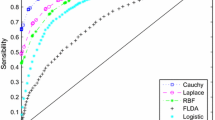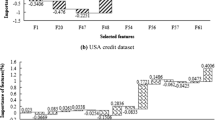Abstract
This paper presents the modelling possibilities of kernel-based approaches to a complex real-world problem, i.e. corporate and municipal credit rating classification. Based on a model design that includes data pre-processing, the labelling of individual parameter vectors using expert knowledge, the design of various support vector machines with supervised learning as well as kernel-based approaches with semi-supervised learning, this modelling is undertaken in order to classify objects into rating classes. The results show that the rating classes assigned to bond issuers can be classified with high classification accuracy using a limited subset of input variables. This holds true for kernel-based approaches with both supervised and semi-supervised learning.




Similar content being viewed by others
References
Abe S (2005) Support vector machines for pattern classification. Springer-Verlag, London
Ahn H, Kim KJ (2005) Combining pairwise SVM classifiers for bond rating. In, Proc of KMIS int conf, pp 586–590
Altman E, Katz S (1976) Statistical bond rating classification using financial and accounting data. In: Sorter G, Schiff M (eds) Topical research in accounting. NYU Press, New York
Ammar S, Duncombe W, Hou Y (2001) Using fuzzy rule-based systems to evaluate overall financial performance of governments: An enhancement to the bond rating process. Public Budg Finance 21:91–110
Bennett KP, Demiriz A (1999) Semi-supervised support vector machines. In: Proc of int conf on advances in neural information processing systems. MIT Press, Cambridge
Brabazon A, O’Neill M (2006) Credit classification using grammatical evolution. Inform 30:325–335
Brennan D, Brabazon A (2004) Corporate bond rating using neural networks. In: Proc of the conf on artificial intelligence, Las Vegas, pp 161–167
Carleton WT, Lerner EM (1969) Statistical scoring of municipal bonds. J Money Credit Bank 11:750–764
Chapelle O, Schölkopf B, Zien A (2006) Semi-supervised learning. MIT Press, Cambridge
Chapelle O, Zien A (2005) Semi-supervised classification by low density separation. In: Proc of the 10th int workshop on artificial intelligence and statistics, Barbados
Chaveesuk R, Srivaree-Ratana C (1999) Alternative neural network approaches to corporate bond rating. J Eng Valuat Cost Anal 2:117–131
Copeland RM, Ingram RW (1982) The association between municipal accounting information and bond rating changes. J Account Res 20:275–289
Cristianini N, Shawe-Taylor J (2000) An introduction to support vector machines and other kernel-based learning methods. Cambridge University Press, Cambridge
Delahunty A, OCallaghan D (2004) Artificial immune systems for the prediction of corporate failure and classification of corporate bond ratings. University College Dublin, Dublin
Dutta S, Shekhar S (1988) Bond rating: a non-conservative application of neural networks. In: Proc of the IEEE international conf on neural networks, pp 443–450
Farnham PG, Cluff GS (1982) Municipal bond ratings: New directions, new results. Publ Finance Quantum 26:427–455
Farnham PG, Cluff GS (1984) Standard and Poor’s vs. Moody’s: Which city characteristics influence municipal bond ratings? Quantum Rev Econ Bus 24:72–94
Garavaglia S (1991) An application of a counter-propagation neural networks: Simulating the Standard & Poor’s corporate bond rating system. In: Proc. of the 1st int conf on artificial intelligence on Wall Street, pp 278–287
Hajek P, Olej V (2008) Municipal creditworthiness modelling by Kohonen’s self-organizing feature maps and fuzzy logic neural networks. In: Kurkova V, Neruda R, Koutnik J (eds) Lecture notes in artificial intelligence. Springer-Verlag, Heidelberg, pp 533–542
Hajek P, Olej V (2007) Municipal creditworthiness modelling by clustering methods. In: Margaritis I (ed) Proc of the 10th int conf on engineering applications of neural networks, pp 168–177
Haykin S (1999) Neural networks: a comprehensive foundation. Prentice-Hall, New Jersey
Horrigan JL (1966) The determination of long term credit standing with financial ratios, empirical research in accounting: selected studies. J Account Res 4
Horton JJ (1970) Statistical classification of municipal bonds. J Bank Res 3:29–40
Huang Z, Chen H (2004) Credit rating analysis with support vector machines and neural networks: A market comparative study. Decis Supp Syst 37:543–558
ChL Huang, MCh Chen, ChJ Wang (2007) Credit scoring with a data mining approach based on support vector machines. Exp Syst Appl 33:847–856
Huang TM, Kecman V (2004) Semi-supervised learning from unbalanced labeled data—an improvement. Lecture Notes Comput Sci 3215:765–771
Huang TM, Kecman V (2005) Semi-supervised learning from unbalanced labeled data—an improvement. Special Issue of KES Int J, ISO press, Netherlands
Huang TM, Kecman V (2005) Performance comparison of semi-supervised learning algorithms. The 22nd conf on machine learning. ICML 2005:45–49
Huang TM, Kecman V, Kopriva I (2006) Kernel based algorithms for mining huge data sets. Supervised. semi-supervised, and unsupervised learning. Studies in computational intelligence, Springer-Verlag, Berlin, Heidelberg
RCh Hwang, Cheng KF (2008) On multiple-class prediction of issuer credit ratings. Appl Stoch Models Bus Ind 5:535–550
Jackson JD, Boyd JW (1988) A statistical approach to modelling the behavior of bond raters. J Behav Econ 17:173–193
Kamstra M, Kennedy P, Suan TK (2001) Combining bond rating forecasts using logit. Financ Rev 37:75–96
Kaplan RS, Urwitz G (1979) Statistical models of bond ratings: a methodological inquiry. J Bus 52:231–261
Kim JW (1993) Expert systems for bond rating: A comparative analysis of statistical, rule-based and neural network systems. Exp Syst 10:167–171
Kim KS (2005) Predicting bond ratings using publicly available information. Exp Syst Appl 29:75–81
Kim KS, Han I (2001) The cluster-indexing method for case-based reasoning using self-organizing maps and learning vector quantization for bond rating cases. Exp Syst Appl 21:147–156
Klose A (2004) Extracting fuzzy classification rules from partially labelled data. Soft Comput 8:417–427
Kwon YS, Han IG (1997) Ordinal pairwise partitioning approach to neural networks training in bond rating. Intell Syst Account Fin Manag 6:23–40
Lee YCh (2007) Application of support vector machines to corporate credit rating prediction. Exp Syst Appl 33:67–74
Loviscek LA, Crowley FD (1990) What is in a municipal bond rating? Financ Rev 25:25–53
Loviscek LA, Crowley FD (2003) Municipal bond ratings and municipal debt management. Marcel Dekker, New York
Maher JJ, Sen TK (1997) Predicting bond ratings using neural networks: A comparison with logistic regression. Intell Syst Account Fin Manag 6:59–72
Michel AJ (1977) Municipal bond rating: Discriminant analysis approach. J Finan Quant Anal 12:587–598
Moody J, Utans J (1995) Architecture selection strategies for neural networks application to corporate bond rating. In: Refenes A (ed) Neural networks in the capital markets. Wiley, Chichester, pp 277–300
Morton TG (1975) A comparative analysis of Moody’s and Standard and Poor’s municipal bond ratings. Rev Bus Econ Res 1:74–81
Olej V, Hajek P (2007) Hierarchical structure of fuzzy inference systems design for municipal creditworthiness modelling. WSEAS Trans Syst Cont 2:162–169
Pinches GE, Mingo KA (1973) A multivariate analysis of industrial bond ratings. J Finance 28:1–18
Serve S (2001) Assessment of local financial risk: The determinants of the rating of European local authorities - an empirical study over the period 1995–1998. EFMA Lugano, Lugano
Shin KS, Han I (2001) A case-based approach using inductive indexing for corporate bond rating. Decis Supp Syst 32:41–52
Singleton JC, Surkan AJ (1995) Bond rating with neural networks. In: Refenes A (ed) Neural networks in the capital markets. Wiley, Chichester, pp 301–307
Stock D, Robertson T (1981) Improved techniques for predicting municipal bond ratings. J Bank Res 12:153–160
Vapnik VN (1995) The nature of statistical learning theory. Springer-Verlag, New York
West RR (1970) An alternative approach to predicting corporate bond ratings. J Account Res 8:118–125
Zhou D, Bousquet O, Lal TN, Weston J, Schölkopf B (2004) Learning with local and global consistency. In: Thrun S, Saul L, Schölkopf B (eds) Advances in neural information processing systems 16. MIT Press, Cambridge, pp 321–328
Zhou D, Schölkopf B (2004) A regularization framework for learning from graph data. In: Workshop on statistical relational learning at 21st int conf on machine learning, pp 132–137
Zhu X (2005) Semi-supervised learning: literature survey. http://www.cs.wisc.edu/~jerryzhu/pub/ssl_survey. Accessed 6 June 2009
Zhu XJ, Ghahramani Z, Lafferty J (2003) Semisupervised learning using Gaussian fields and harmonic functions. In: Proc of the 20th int conf on machine learning, Washington, DC
Acknowledgments
This work was supported by a scientific research grant by the Czech Science Foundation, under Grant No: 402/09/P090 with the title Modelling of Municipal Finance by Computational Intelligence Methods and Grant No: 402/08/0849 with the title Model of Sustainable Regional Development Management.
Author information
Authors and Affiliations
Corresponding author
Rights and permissions
About this article
Cite this article
Hájek, P., Olej, V. Credit rating modelling by kernel-based approaches with supervised and semi-supervised learning. Neural Comput & Applic 20, 761–773 (2011). https://doi.org/10.1007/s00521-010-0495-0
Received:
Accepted:
Published:
Issue Date:
DOI: https://doi.org/10.1007/s00521-010-0495-0




